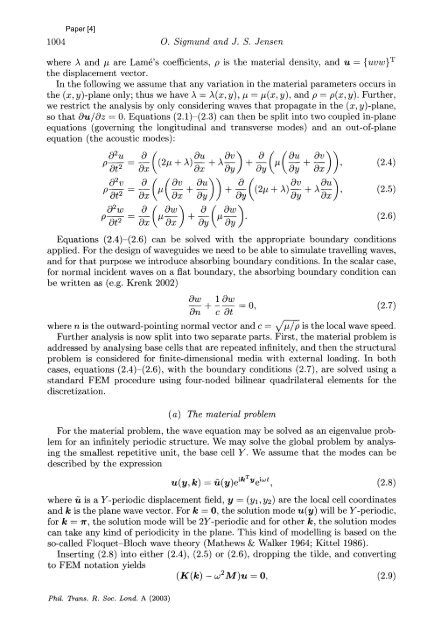WAVES AND VIBRATIONS IN INHOMOGENEOUS STRUCTURES ...
WAVES AND VIBRATIONS IN INHOMOGENEOUS STRUCTURES ...
WAVES AND VIBRATIONS IN INHOMOGENEOUS STRUCTURES ...
Create successful ePaper yourself
Turn your PDF publications into a flip-book with our unique Google optimized e-Paper software.
1004<br />
O. Sigmund and J. S. Jensen<br />
where A and ,u are Lame's coefficients, p is the material density, and u {uvw}T<br />
the displacement vector.<br />
In the following we assume that any variation in the material parameters occurs in<br />
the (x, y)-plane only; thus we have A = A(x, y), ,L = -u(x, y), and p = p(x, y). Further,<br />
we restrict the analysis by only considering waves that propagate in the (x, y)-plane,<br />
so that Ou/Oz = 0. Equations (2.1)-(2.3) can then be split into two coupled in-plane<br />
equations (governing the longitudinal and transverse modes) and an out-of-plane<br />
equation (the acoustic modes):<br />
Pt2 = a<br />
(2/,+A) a + -<br />
Pt2 -Ox O2 x A Dy +3ya((,9 y ay y x<br />
Q ^ay (~Lh)<br />
v 9u\<br />
(2.4)<br />
P2 = , + au)) + a<br />
(2 + A) ?v + A (2.5)<br />
9t2 ax\ 9x 9y ) 9yy 19Y Ox<br />
02w a ( 9w\ ( 9Ow\<br />
P9t2 Ax Ax tO ) +y ay (2.6)<br />
/ DyOxDy<br />
Equations (2.4)-(2.6) can be solved with the appropriate boundary conditions<br />
applied. For the design of waveguides we need to be able to simulate travelling waves,<br />
and for that purpose we introduce absorbing boundary conditions. In the scalar case,<br />
for normal incident waves on a flat boundary, the absorbing boundary condition can<br />
be written as (e.g. Krenk 2002)<br />
9w 1 8w<br />
+- = 0, (27)<br />
On c Ot<br />
where n is the outward-pointing normal vector and c = /-/p is the local wave speed.<br />
Further analysis is now split into two separate parts. First, the material problem is<br />
addressed by analysing base cells that are repeated infinitely, and then the structural<br />
problem is considered for finite-dimensional media with external loading. In both<br />
cases, equations (2.4)-(2.6), with the boundary conditions (2.7), are solved using a<br />
standard FEM procedure using four-noded bilinear quadrilateral elements for the<br />
discretization.<br />
(a) The material problem<br />
For the material problem, the wave equation may be solved as an eigenvalue prob-<br />
lem for an infinitely periodic structure. We may solve the global problem by analys-<br />
ing the smallest repetitive unit, the base cell Y. We assume that the modes can be<br />
described by the expression<br />
u(y, k) = u(y)eikTYeit, (2.8)<br />
where i is a Y-periodic displacement field, y = (yl, Y2) are the local cell coordinates<br />
and k is the plane wave vector. For k = 0, the solution mode u(y) will be Y-periodic,<br />
for k = r, the solution mode will be 2Y-periodic and for other k, the solution modes<br />
can take any kind of periodicity in the plane. This kind of modelling is based on the<br />
so-called Floquet-Bloch wave theory (Mathews & Walker 1964; Kittel 1986).<br />
Inserting (2.8) into either (2.4), (2.5) or (2.6), dropping the tilde, and converting<br />
to FEM notation yields<br />
(K(k) -2M) = 0, (2.9)<br />
Phil. Trans. R. Soc. Lond. A (2003)

















